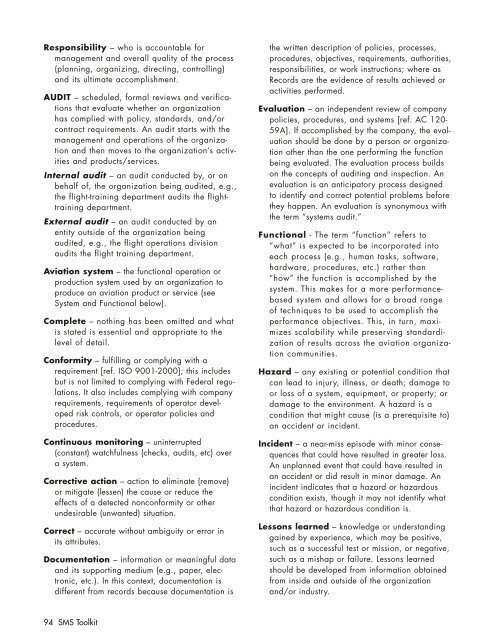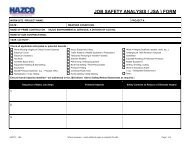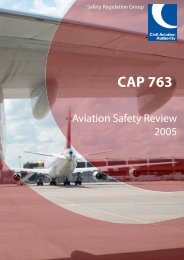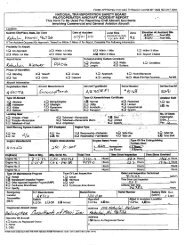International Helicopter Safety Team Safety Management System Toolkit
IHST - Safety Management Toolkit - Skybrary
IHST - Safety Management Toolkit - Skybrary
- No tags were found...
Create successful ePaper yourself
Turn your PDF publications into a flip-book with our unique Google optimized e-Paper software.
Responsibility – who is accountable for<br />
management and overall quality of the process<br />
(planning, organizing, directing, controlling)<br />
and its ultimate accomplishment.<br />
AUDIT – scheduled, formal reviews and verifications<br />
that evaluate whether an organization<br />
has complied with policy, standards, and/or<br />
contract requirements. An audit starts with the<br />
management and operations of the organization<br />
and then moves to the organization’s activities<br />
and products/services.<br />
Internal audit – an audit conducted by, or on<br />
behalf of, the organization being audited, e.g.,<br />
the flight-training department audits the flighttraining<br />
department.<br />
External audit – an audit conducted by an<br />
entity outside of the organization being<br />
audited, e.g., the flight operations division<br />
audits the flight training department.<br />
Aviation system – the functional operation or<br />
production system used by an organization to<br />
produce an aviation product or service (see<br />
<strong>System</strong> and Functional below).<br />
Complete – nothing has been omitted and what<br />
is stated is essential and appropriate to the<br />
level of detail.<br />
Conformity – fulfilling or complying with a<br />
requirement [ref. ISO 9001-2000]; this includes<br />
but is not limited to complying with Federal regulations.<br />
It also includes complying with company<br />
requirements, requirements of operator developed<br />
risk controls, or operator policies and<br />
procedures.<br />
Continuous monitoring – uninterrupted<br />
(constant) watchfulness (checks, audits, etc) over<br />
a system.<br />
Corrective action – action to eliminate (remove)<br />
or mitigate (lessen) the cause or reduce the<br />
effects of a detected nonconformity or other<br />
undesirable (unwanted) situation.<br />
Correct – accurate without ambiguity or error in<br />
its attributes.<br />
Documentation – information or meaningful data<br />
and its supporting medium (e.g., paper, electronic,<br />
etc.). In this context, documentation is<br />
different from records because documentation is<br />
the written description of policies, processes,<br />
procedures, objectives, requirements, authorities,<br />
responsibilities, or work instructions; where as<br />
Records are the evidence of results achieved or<br />
activities performed.<br />
Evaluation – an independent review of company<br />
policies, procedures, and systems [ref. AC 120-<br />
59A]. If accomplished by the company, the evaluation<br />
should be done by a person or organization<br />
other than the one performing the function<br />
being evaluated. The evaluation process builds<br />
on the concepts of auditing and inspection. An<br />
evaluation is an anticipatory process designed<br />
to identify and correct potential problems before<br />
they happen. An evaluation is synonymous with<br />
the term “systems audit.”<br />
Functional - The term “function” refers to<br />
“what” is expected to be incorporated into<br />
each process (e.g., human tasks, software,<br />
hardware, procedures, etc.) rather than<br />
“how” the function is accomplished by the<br />
system. This makes for a more performancebased<br />
system and allows for a broad range<br />
of techniques to be used to accomplish the<br />
performance objectives. This, in turn, maximizes<br />
scalability while preserving standardization<br />
of results across the aviation organization<br />
communities.<br />
Hazard – any existing or potential condition that<br />
can lead to injury, illness, or death; damage to<br />
or loss of a system, equipment, or property; or<br />
damage to the environment. A hazard is a<br />
condition that might cause (is a prerequisite to)<br />
an accident or incident.<br />
Incident – a near-miss episode with minor consequences<br />
that could have resulted in greater loss.<br />
An unplanned event that could have resulted in<br />
an accident or did result in minor damage. An<br />
incident indicates that a hazard or hazardous<br />
condition exists, though it may not identify what<br />
that hazard or hazardous condition is.<br />
Lessons learned – knowledge or understanding<br />
gained by experience, which may be positive,<br />
such as a successful test or mission, or negative,<br />
such as a mishap or failure. Lessons learned<br />
should be developed from information obtained<br />
from inside and outside of the organization<br />
and/or industry.<br />
94 SMS <strong>Toolkit</strong>







